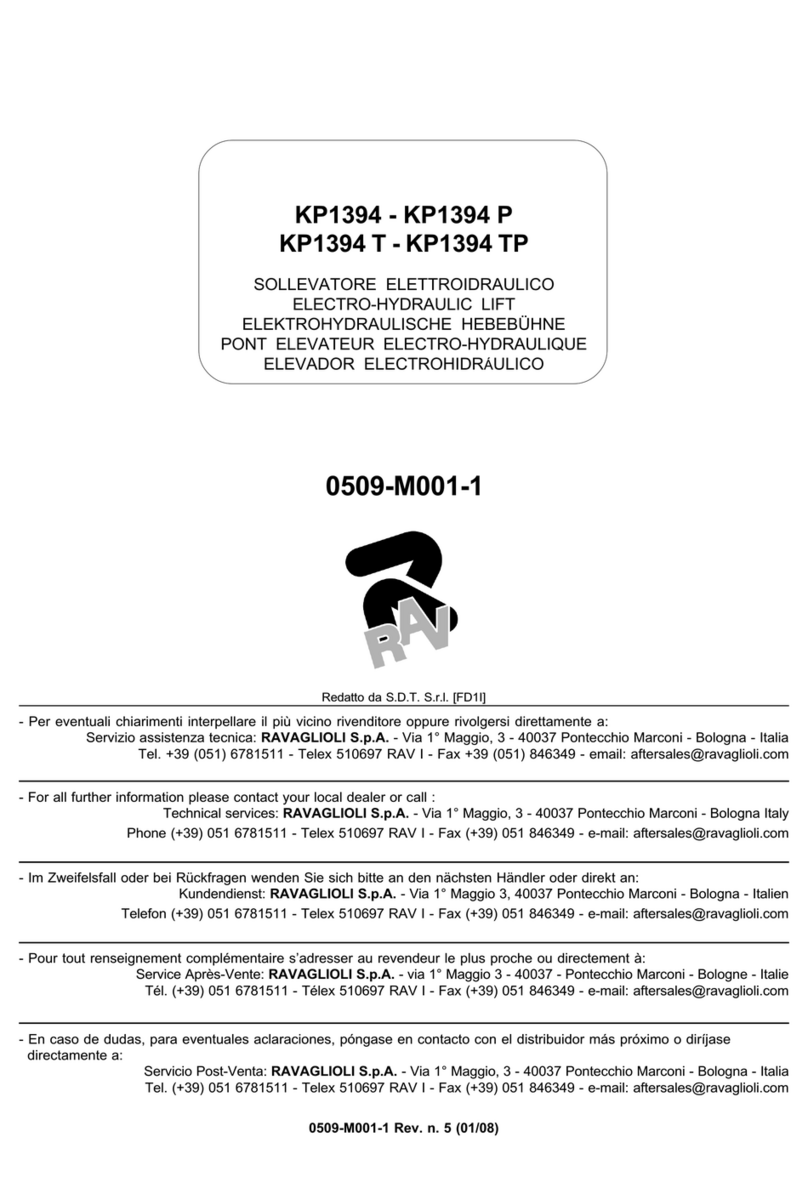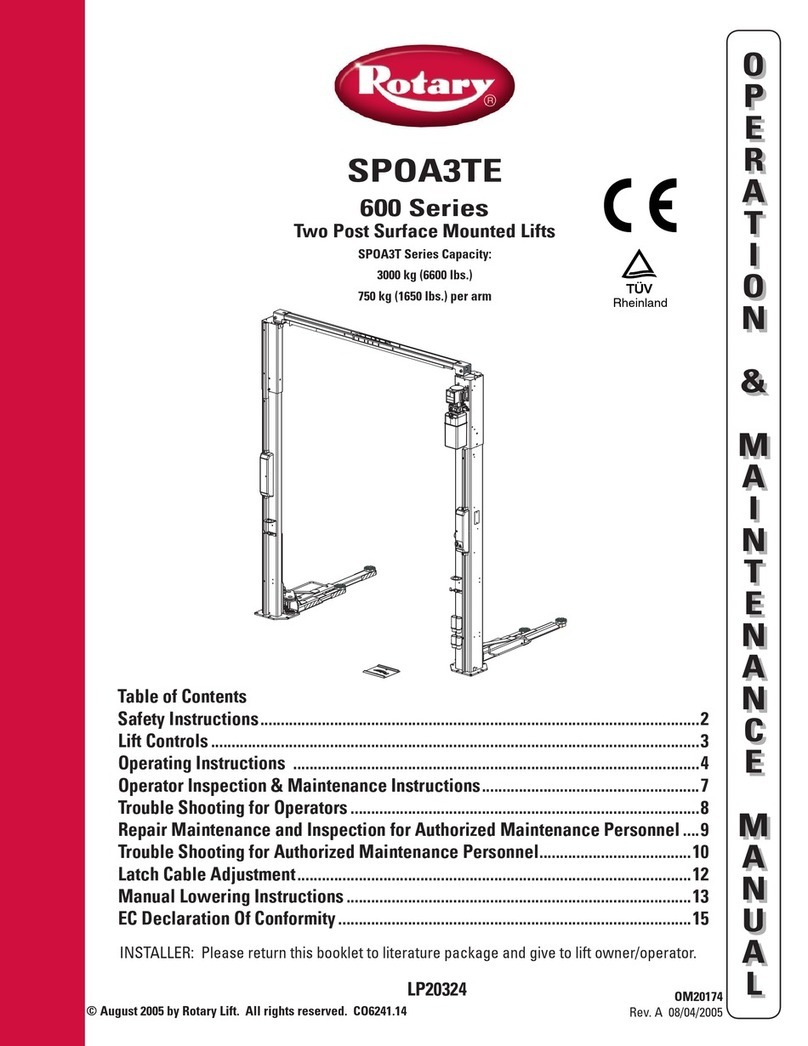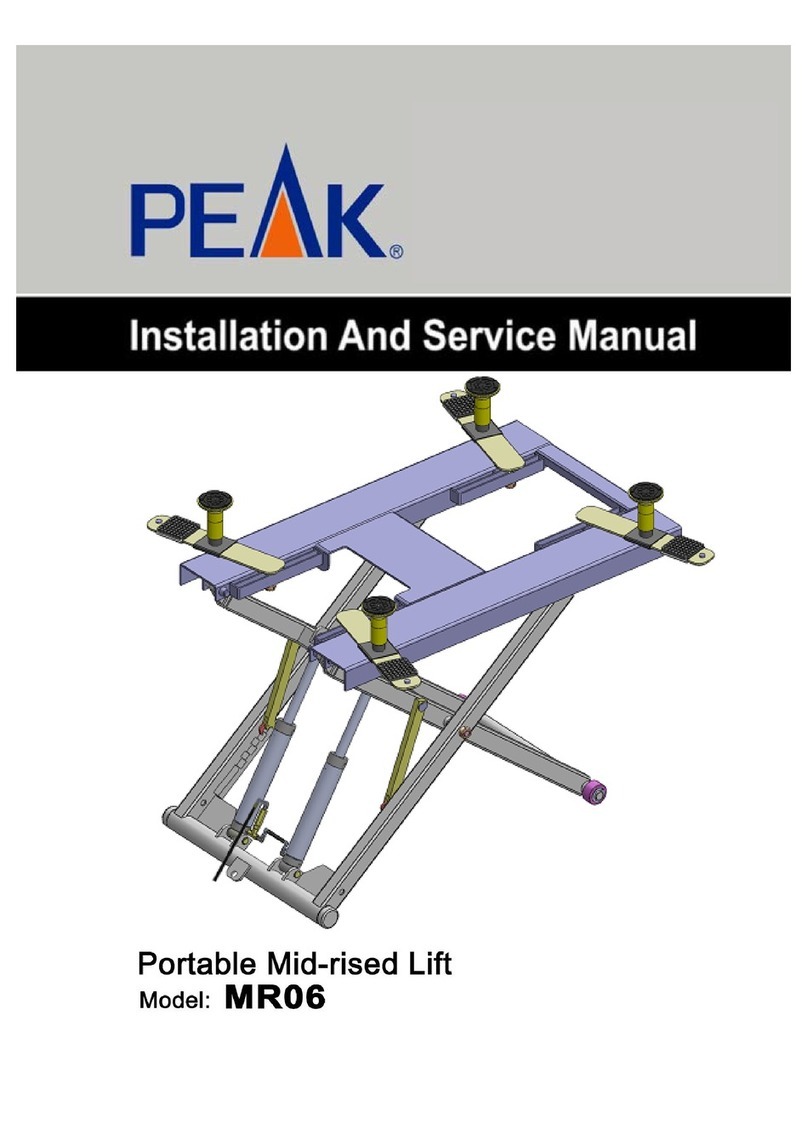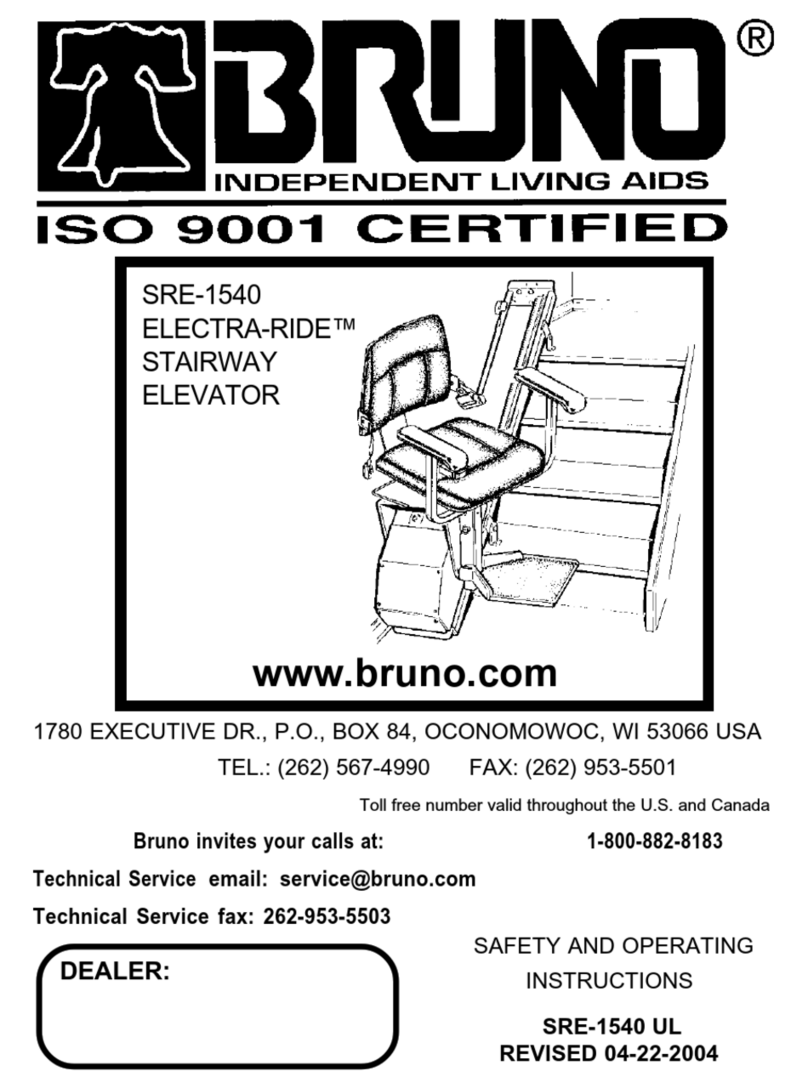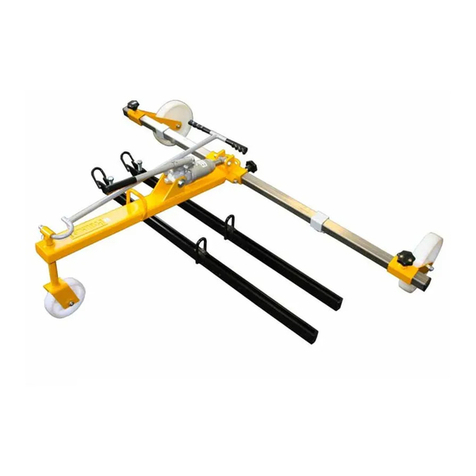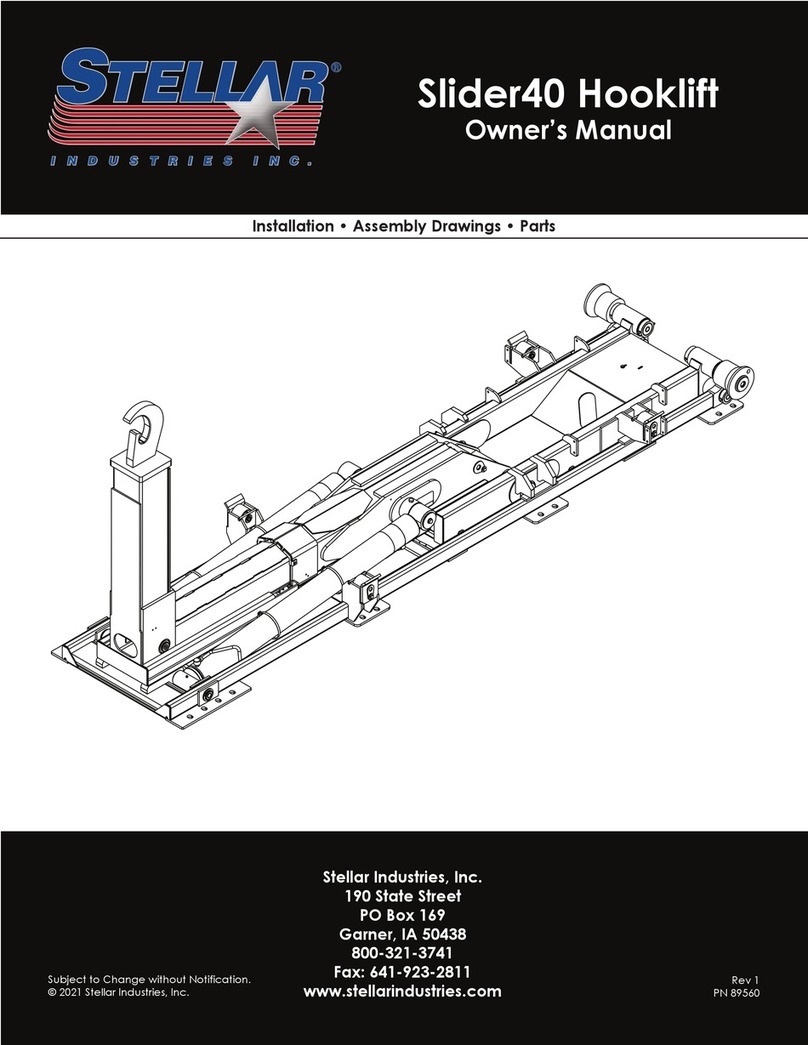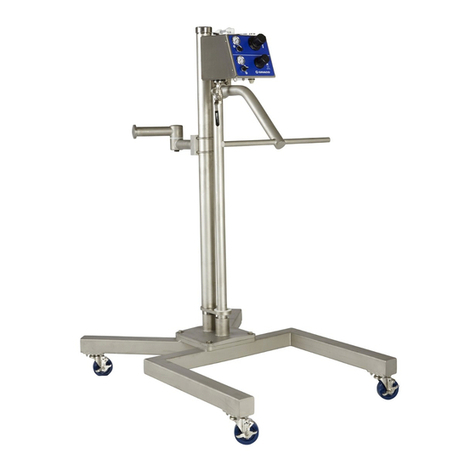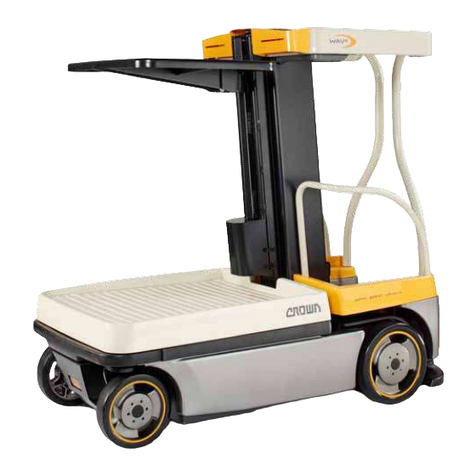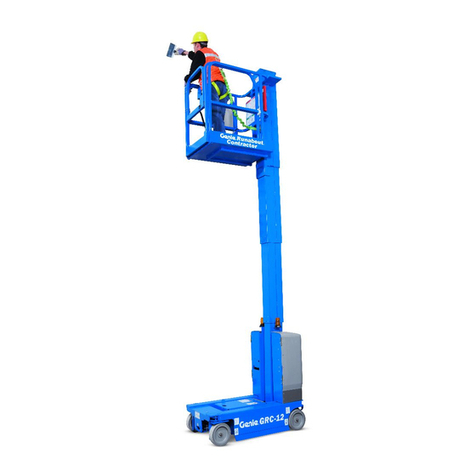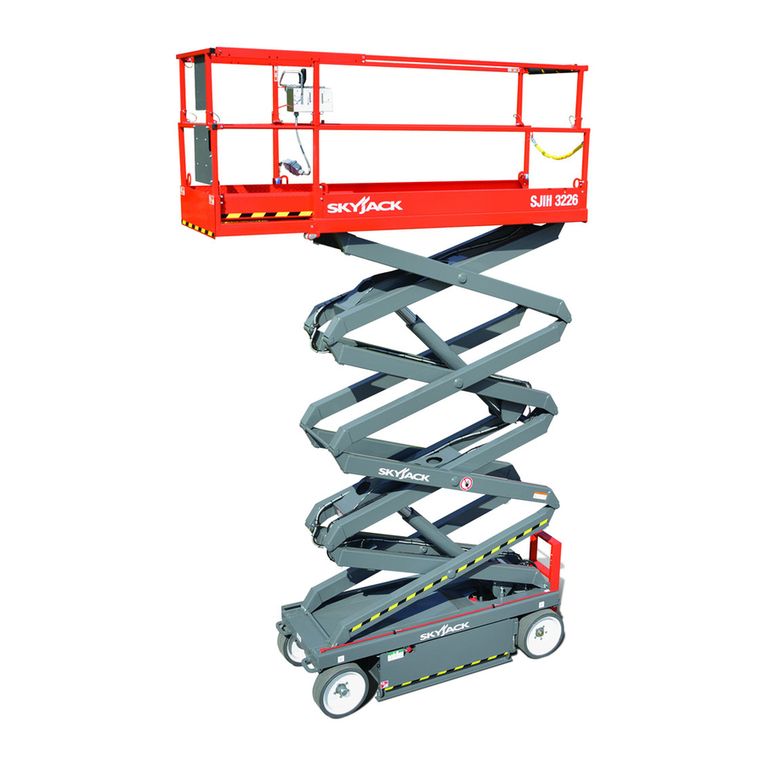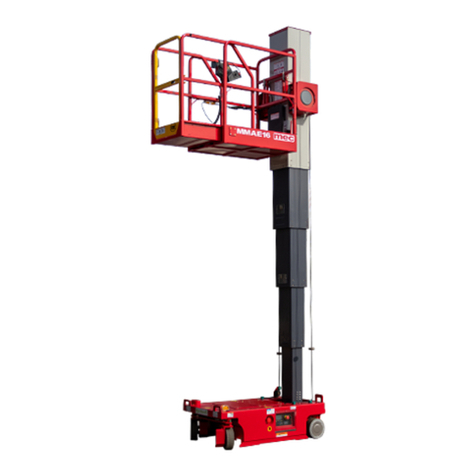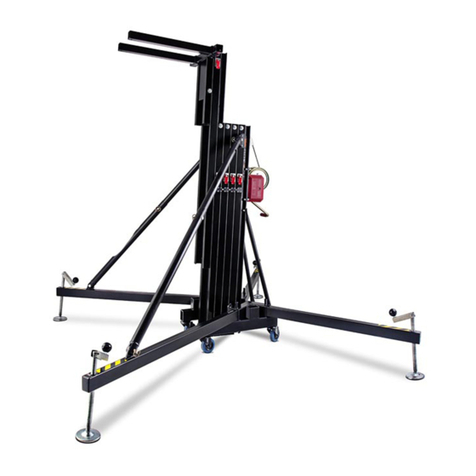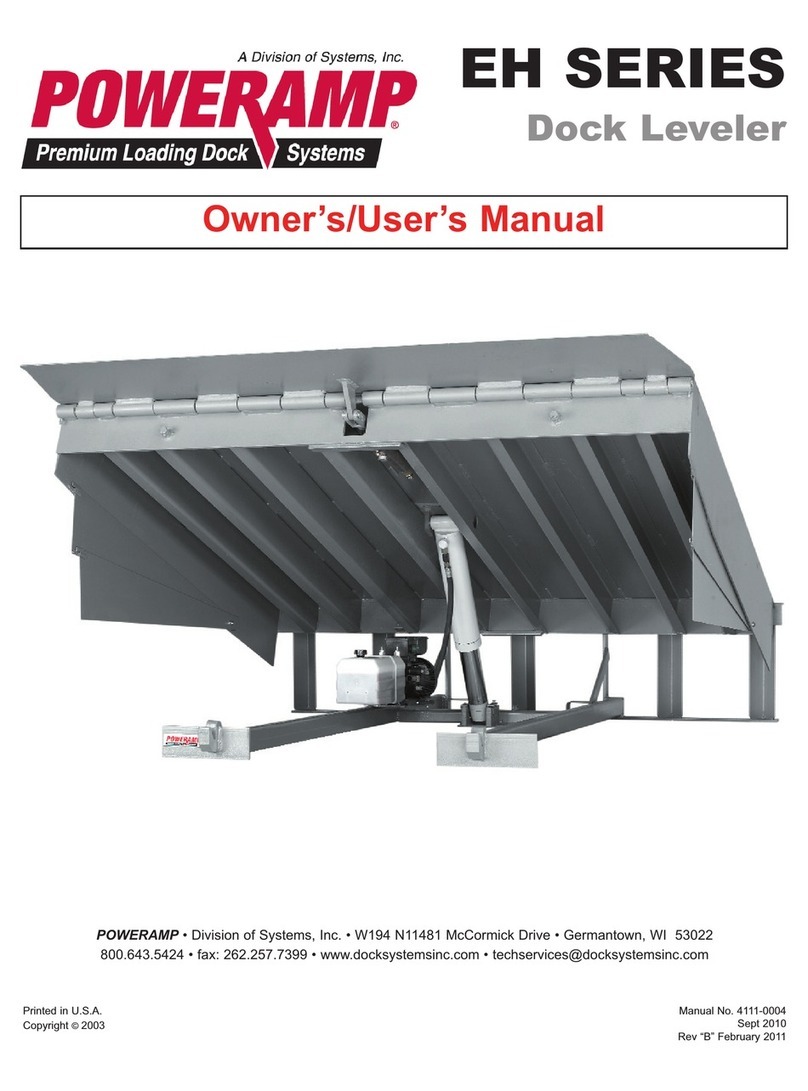Golf-Lift GL-9 Instruction Manual

GL-9 Floor Plate Lift IN50018 Rev. B 05/30/2008
1
GL-9
Floor Plate Automotive/Golf Equipment Lift
9,000 Pound Capacity for 4-wheel Vehicles
6,500 Pound Capacity for 3-Wheel Vehicles
INSTALLATION / OWNERS MANUALS
Read this manual thoroughly before installing, operating, or maintaining this lift. When done with
installation, be sure to return documents to package and give all materials to lift owner/operator. When
installation is complete, be sure to run lift up and down a few cycles with and without “typical” vehicle
loaded on lift.
IMPORTANT Reference ANSI/ALI ALIS,
Safety Requirements for
Installation and Service of Automotive Lifts
before installing lift.

GL-9 Floor Plate Lift IN50018 Rev. B 05/30/2008
2
TABLE OF CONTENTS
• IMPORTANT INFORMATION ................................................................... 2
• GENERAL LIFT INFORMATION / FEATURES......................................... 3
• LIFT SPECIFICATIONS FOR GOLF LIFT ................................................ 3
• LIFT SPECIFICATIONS WITH ARM KIT .................................................. 5
• LIFT AREA LAYOUT INFORMATION ...................................................... 6
• FOUNDATION and ANCHORING REQUIREMENTS ............................... 7
• TOOLS and EQUIPMENT REQUIRED for INSTALL................................ 8
• INSTALLATION PROCEDURE................................................................. 9
• OWNER / EMPLOYER RESPONSIBILITIES ............................................ 14
• LIFT LOCKOUT/TAGOUT ........................................................................ 15
• SAFETY PROCEDURES .......................................................................... 16
• LIFT OPERATION..................................................................................... 18
• PREVENTIVE MAINTENANCE SCHEDULE ............................................ 20
• TROUBLESHOOTING .............................................................................. 22
• ILLUSTRATED PARTS BREAKDOWN.................................................... 24
• PARTS LIST.............................................................................................. 28
• WARRANTY POLICY ............................................................................... 31
IMPORTANT INFORMATION
Two Post Lifts
1. Any freight damage must be noted on the freight bill before signing and reported to the freight carrier
with a freight claim established. Identify the components and check for shortages. If shortages are
discovered, please contact the Distributor / Sales Rep. in your area for service.
2. Consult building owner and / or architect’s plans when applicable to establish the best lift location. The
lift should be located on a relatively level floor with 4 in. minimum thickness, 3000-psi concrete slab
that has been properly cured. There can be no cracks in the slab within 36 in. of the base plate
location, and no seams in the foundation within 6 in. of its location! Remember: any structure
is only as strong as the foundation on which it is located!
IMPORTANT! Make sure you have extra help or heavy duty lifting equipment when
unloading and assembling the lift.
3. Please read the safety procedures and operating instructions in this manual before operating lift. Keep
this manual near lift at all times. Make sure all operators read this manual.
4. The lift should be located on a relatively level floor of less than 3 degrees slope. If slope is
questionable, consider a survey of the site and/or the possibility of pouring a new level concrete slab.
5. Make sure you have enough area and ceiling height to install lift. (See Lift Specifications)
6. Never raise a car until you have double checked all bolts, nuts and hose fittings.
7. Always lower the lift onto the locks before going under the vehicle. Never allow anyone to go under
the lift when raising or lowering.
This is a vehicle lift installation/operation manual and no attempt is made or implied herein to
instruct the user in lifting methods particular to an individual application. Rather, the contents of
this manual are intended as a basis for operation and maintenance of the unit as it stands alone
or as it is intended and anticipated to be used in conjunction with other equipment.
Proper application of the equipment described herein is limited to the parameters detailed in the
specifications and the uses set forth in the descriptive passages. Any other proposed
application of this equipment should be documented and submitted in writing to the factory for
examination. The user assumes full responsibility for any equipment damage, personal injury, or
alteration of the equipment described in this manual or any subsequent damages.

GL-9 Floor Plate Lift IN50018 Rev. B 05/30/2008
3
CAUTION!!
ENSURE THAT ALL CABLE SHEAVES, BEARINGS, AND SHAFTS ARE SUFFICIENTLY
LUBRICATED. ALSO, THE CORNERS OF EACH COLUMN SHOULD BE LIGHTLY
GREASED WITH QUALITY LITHIUM GREASE PRIOR TO OPERATING THE LIFT.
LUBRICATE ALL ON AN ANNUAL BASIS.
Motors and all electrical components are not sealed against the weather and moisture.
Install this lift in a protected indoor location. Failure by the owner to provide the
recommended shelter could result in unsatisfactory lift performance, property damage,
or personal injury.
GENERAL LIFT INFORMATION and FEATURES
FLOOR PLATE MODEL
The following lift is a 2-Column Hydraulic, leaf chain driven unit.
This lift is a 2-Post Lift. The locking latch system is very similar to an extension ladder.
The locking latch is in contact with the latch rack. As the lift rises the locking latch drops
into place. The locking latch engages the latch rack in 3” increments starting at about
16” from the ground. The locking latches must be manually disengaged for the lift to
lower. The locking latch is released by pulling the Release Cable, first raising the lift to
get the latch up off the latch rack. Once the raise button is pressed, the latch will
automatically reengage after approximately 3" of travel. Heavy bearings and heavy-duty
leaf chains are used throughout the lift. The work is done with the heavy-duty chain
connected to a 2-1/2" cylinder, driven by an electric / hydraulic pump.
Lift Specifications for Golf Lift
Capacity 9,000 lbs. for 4-wheel vehicles
6,500 lbs. for 3-wheel vehicles
Overall Height 111-1/4"
Overall Floor Width 138-1/2"
Maximum Lift Height 81"
Minimum Adapter Height 7"
Between Columns 111"
Drive Thru 97-1/4"
Motor 2HP, 208 - 230 VAC, 1PH

GL-9 Floor Plate Lift IN50018 Rev. B 05/30/2008
4
20 15/32"
138 7/16"
111 3/32"
110 23/32"
71 31/32"
12 13/32"

GL-9 Floor Plate Lift IN50018 Rev. B 05/30/2008
5
Lift Specifications with Arm Kit
Capacity 9,000 lbs. (2,250 lbs per Arm)
Overall Height 111-1/4"
Overall Floor Width 138-1/2"
Maximum Lift Height 81"
Minimum Adapter Height 7"
Between Columns 111"
Drive Thru 97-1/4"
Motor 2HP, 208 - 230 VAC, 1PH
138-1/2”
59” Max Arm Reach
33-3/4” Min Arm Reach
16”
111”
107”
97-1/4” Drive-thru
Clearance
1-1/2” Drive Over
7” Adapter Height
111-1/4”

GL-9 Floor Plate Lift IN50018 Rev. B 05/30/2008
6
LIFT AREA LAYOUT INFORMATION
(Symmetrical Arm configuration)
6' 0" (1829mm) minimum to
nearest obstruction or bay.
7' 0" (2134mm) minimum to
nearest wall.
12' 0" (3658mm)
minimum to nearest
obstruction
APPROACH
12' 0" (3658mm)
minimum to nearest
obstruction
Power Unit
NOTE: Lift can be installed so power unit can column can be located on
either side. However, to save operation steps it is recommended that it is
placed on passenger side of lift.

GL-9 Floor Plate Lift IN50018 Rev. B 05/30/2008
7
FOUNDATION and ANCHORING REQUIREMENTS
1. Concrete shall have compression strength of at least 3,000 PSI and a minimum thickness
of 4” in order to achieve a minimum anchor embedment of 3 1/4”. NOTE: When using the
standard supplied 3/4” x 5 1/2 long anchors, if the top of the anchor exceeds 2 1/4” above
the floor grade, you DO NOT have enough embedment.
2. Maintain a 6” minimum distance from any slab edge or seam. Hole to hole spacing
should be a minimum 61/2” in any direction. Hole depth should be a minimum of 4”.
CAUTION!!
3. DO NOT install on asphalt or other similar unstable surface. Columns are supported only
by anchoring to floor.
4. Using the horseshoe shims provided, shim each column base as required until each
column is plumb. If one column has to be elevated to match the plane of the other column,
full size base shim plates should be used. Torque anchors to 150 ft-lbs. Shim thickness
MUST NOT exceed 1/2” when using the 5 1/2” long anchors provided with the lift. Adjust
the column extensions plumb.
5. If anchors do not tighten to 150 ft-lbs. installation torque, replace the concrete under each
column base with a 4’ x 4’ x 6” thick 3,000 PSI minimum concrete pad keyed under and
flush with the top of existing floor. Allow concrete to cure before installing lifts and
anchors (typically 2 to 3 weeks).

GL-9 Floor Plate Lift IN50018 Rev. B 05/30/2008
8
TOOLS & EQUIPMENT REQUIRED FOR INSTALL
The installation of this lift is relatively simple and can be accomplished by two men in a
few hours. The following tools and equipment are needed:
• Hoist or Forklift (optional)
• Two 10’ to 12’ step ladders
• ISO 32 Light Hydraulic Oil (approx. 12 quarts)
• Tape Measure
• Rotary Hammer Drill with 3/4" and 3/8" Drill Bit (Core Drill Rebar Cutter recommended)
• 4’ Level
• Metric Sockets and Open Wrench set
• Vise grips
• 8mm Socket Head Wrench
• Torque wrench with 1-1/8" socket for anchors
• Teflon Tape

GL-9 Floor Plate Lift IN50018 Rev. B 05/30/2008
9
INSTALLATION PROCEDURE
STEP 1: After unloading the lift, place it near the intended installation location.
STEP 2: Remove the shipping bands and packing materials from the unit. The Power Unit will
be unpacked from the top. Note: Be careful not to drop power unit.
STEP 3: Remove the packing brackets and bolts holding the two columns together (do not
discard bolts; they are used in the assembly of the lift).
STEP 4: Once the power unit column location is decided, insure that the proper lift placement is
observed from walls and obstacles. Also check the ceiling height for clearance in this location.
NOTE: Lift can be installed so power unit can column can be located on either side.
However, to save operation steps it is recommended that it is placed on passenger side
of lift.
STEP 5: Install the top plate onto the top of the columns. NOTE: 1" = 25.4mm
M12 x 50mm Bolt
Washer
Lockwasher
& M12 Nut
STEP 6: Position the columns facing each other 138-1/2” outside base plates. Square the
columns by measuring diagonally from corner points on base plates (within 1/4”). See plan and
elevation drawings on page 4 for detailed drawing.
STEP 7: Use the existing holes in column base plate as a guide for drilling the 3/4” diameter
holes into the concrete. Drill the anchor holes, installing anchors as you go. Verify drive over
plate will fit between column baseplates before anchoring second column.
NOTE: Drilling thru concrete slab (recommended) will allow the anchor to be driven thru the
bottom of slab, if the threads are damaged or if the lift will need to be relocated.
CAUTION!!
Anchors must be at least 6” from the edge of the slab or any seam.
1. Use a concrete hammer drill with a carbide tip, solid drill bit the same diameter as
the anchor, 3/4”. (.775 to .787 inches diameter). Do not use excessively worn bits or
bits which have been incorrectly sharpened.

GL-9 Floor Plate Lift IN50018 Rev. B 05/30/2008
10
2. Keep the drill in a perpendicular line while drilling.
3. Let the drill do the work. Do not apply excessive pressure. Lift the drill up and down
occasionally to remove residue to reduce binding.
4. Drill the hole to depth equal to the length of anchor. Note: Drilling thru concrete
(recommended) will allow the anchor to be driven thru the bottom of foundation if
the threads are damaged or if the lift will need to be relocated.
5. For better holding power blow dust from the hole.
Place a flat washer and hex nut over threaded end of anchor, leaving approximately 1/2"
of thread exposed carefully tap anchor. Do not damage threads. Tap anchor into the
concrete until nut and flat washer are against base plate. Do not use an impact wrench to
tighten! Tighten the nut, two or three turns on average concrete (28-day cure). If the
concrete is very hard only one or two turns may be required. Check each anchor bolt
with torque wrench set to 150 foot pounds.
STEP 8: Using a level, check column for side-to-side plumb and front-to-back plumb. If needed,
use horseshoe shims provided by placing shims underneath the base plate and around the
anchor bolt. This will prevent bending the column bottom plates (Shim thickness should not
exceed 1/2”). Tighten 3/4” anchor bolts to 150 ft-lbs. of torque.
STEP 9: Set carriages on the first safety latch engagement. Be sure each carriage is at the
same height by measuring from the top of the base to the bottom of the carriage (double check
the latches before working under the carriages). This dimension should be within 1/4".
4-1/4” 4-1/4” 3-1/4”
2-1/4”
Drill holes using 3/4”
carbide tipped
masonary drill bit pe
r
A
NSI standard
B94.12.1977
Clean hole. Run nut down just
below impact section
of bolt. Drive ancho
r
into hole until nut and
washer contact base.
Tighten nut with
Torque wrench to
150 ft.-lbs.

GL-9 Floor Plate Lift IN50018 Rev. B 05/30/2008
11
STEP 10: Installing the equalizing cables: (see diagram below) Loosen the two Cable Retaining
Bolts as shown. Route the first cable as shown. Tighten nut on one cable stud so that the end
of stud passes the nylon on the nut. Pull the other end of cable and run nut on it. Repeat above
for second cable. Once installed tighten the Cable Retaining Bolts.
NOTE: DO NOT tighten cables at this time. Just start them on the threads.
Cable
3/4” Nylon Insert Locknut
(Columns Not Shown For Clarity)
Pulley
Cable Retaining Bolt
Cable Retaining Bolt
Pulleys
Ø20 Washer
Ø20 Washer
3/4” Nylon Insert Locknut
Cable
Carriage

GL-9 Floor Plate Lift IN50018 Rev. B 05/30/2008
12
STEP 11: Cylinder centering: Make sure the “Tip” on the bottom of the cylinder is properly
located into the center hole on top of the cylinder mount in base.
STEP 12 Connect the Hydraulic Hoses and Fittings, as shown.
Hydraulic
Nipple
Hydraulic Cylinder
Hydraulic
Nipple Hose
Power Unit
Hydraulic Hose
90º Fitting
M6 x 8
Screw
Hydraulic Extension
90º Fitting
Hose Clip

GL-9 Floor Plate Lift IN50018 Rev. B 05/30/2008
13
STEP 13 Mount the Power Unit on lift as shown.
STEP 14: Mount the Floor Plate as shown below. Drill 3/8" holes using holes in plate as guides.
Following drill steps/directions used when anchoring columns. Tighten to 25 ft-lbs.
Floor Plate
3/8” Anchor
STEP 15: Install the swing arms on the carriages using the included 1-1/2" diameter pins. Check
for proper engagement of the arm lock – the teeth on the lock should fully engage the gear on
the arm. Note, if arm pins are not fitting, you will need to pull up on arm lock to allow slack for
the arm to move around in the carriage, allowing the arm pin to fit easier.
STEP 16: Adjust the carriage cables tension. Adjust each cable to approximately 1/2" side-to-
side play. Check the latch releases to insure the carriage is still sitting on the appropriate latch.

GL-9 Floor Plate Lift IN50018 Rev. B 05/30/2008
14
STEP 17: Remove the vented fill cap from the power unit and fill the reservoir. Use a Ten
Weight (ISO AW32) non-foaming, non-detergent hydraulic fluid (i.e. Texaco HD32 or equal).
The unit will hold approximately twelve quarts of fluid. If a replacement fill cap is required order
from your distributor, a vented cap MUST be used.
STEP 18: Make the Electrical hookup to the power unit; 220V Single Phase. It is recommended
that a 220 Volt, 30 Amp twist lock plug be installed in the power line just ahead of the power unit.
Use wire capable of supporting a 30-amp circuit.
Warning: – the wiring must comply with local code. Have a certified electrician make the
electrical hook-up to the power unit. Protect each circuit with time delay fuse or circuit
breaker; 208v-230v single phase 60 Hz 30 amp.
STEP 19: Do not place any vehicle on the lift at this time. Cycle the lift up and down several
times to insure latches click together and all air is removed from the system. To lower the lift,
both latch releases must be manually released. Latches will automatically reset once the lift
ascends approximately 17” from base. If latches click out of sync, tighten the cable on the one
that clicks first.
STEP 20: With lift fully lowered, recheck power unit fluid level. Fill as required.
OWNER / EMPLOYER RESPONSIBILITIES
The Owner / Employer:
• Shall ensure that lift operators are qualified and that they are trained in the safe use and operation of
the lift using the manufacturer’s operating instructions; ALI/SM01-1, ALI Lifting it Right safety manual;
ALI/ST-90 ALI Safety Tips card; ANSI/ALI ALOIM-2000, American National Standard for Automotive
Lifts-Safety Requirements for Operation, Inspection and Maintenance; ALI/WL Series, ALI Uniform
Warning Label Decals/Placards; and in the case of frame engaging lifts, ALI/LP-GUIDE, Vehicle Lifting
Points/Quick Reference Guide for Frame Engaging Lifts.
• Shall establish procedures to periodically inspect the lift in accordance with the lift manufacturer’s
instructions or ANSI/ALI ALOIM-2000, American National Standard for Automotive Lifts-Safety
Requirements for Operation, Inspection and Maintenance; and The Employer Shall ensure that lift
inspectors are qualified and that they are adequately trained in the inspection of the lift.
• Shall establish procedures to periodically maintain the lift in accordance with the lift manufacturer’s
instructions or ANSI/ALI ALOIM-2000, American National Standard for Automotive Lifts-Safety
Requirements for Operation, Inspection and Maintenance; and The Employer Shall ensure that lift
maintenance personnel are qualified and that they are adequately trained in the maintenance of the lift.
• Shall maintain the periodic inspection and maintenance records recommended by the manufacturer or
ANSI/ALI ALOIM-2000, American National Standard for Automotive Lifts-Safety Requirements for
Operation, Inspection and Maintenance.
• Shall display the lift manufacturer’s operating instructions; ALI/SM 93-1, ALI Lifting it Right safety
manual; ALI/ST-90 ALI Safety Tips card; ANSI/ALI ALOIM-2000, American National Standard for
Automotive Lifts-Safety Requirements for Operation, Inspection and Maintenance; and in the case of
frame engaging lifts, ALI/LP-GUIDE, Vehicle Lifting Points/Quick Reference Guide for Frame Engaging
Lifts; in a conspicuous location in the lift area convenient to the operator.

GL-9 Floor Plate Lift IN50018 Rev. B 05/30/2008
15
• Shall not modify the lift in any manner without the prior written consent of the manufacturer.
• Shall provide necessary lockout/tagout means for energy sources per ANSI Z244.1-1982 (R1993),
Safety Requirements for the Lockout/Tagout of Energy Sources, before beginning any lift repairs.
Lift Lockout/Tagout Procedure
Purpose
This procedure establishes the minimum requirements for the lockout of energy that could cause injury to
personnel by the operation of lifts in need of repair or being serviced. All employees shall comply with
this procedure.
Responsibility
The responsibility for assuring that this procedure is followed is binding upon all employees and service
personnel from outside service companies (i.e., Authorized Installers, contractors, etc.). All employees
shall be instructed in the safety significance of the lockout procedure by the facility owner/manager. Each
new or transferred employee along with visiting outside service personnel, shall be instructed by the
owner/manager (or assigned designee) in the purpose and use of the lockout procedure.
Preparation
Employees authorized to perform lockout shall ensure that the appropriate energy isolating device (i.e.,
circuit breaker, fuse, disconnect, etc.) is identified for the lift being locked out. Other such devices for
other equipment may be located in close proximity of the appropriate energy isolating device. If the
identity of the device is in question, see the shop supervisor for resolution. Assure that proper
authorization is received prior to performing the lockout procedure.
Sequence of Lockout Procedure
1) Notify all affected employees that a lockout is being performed and the reason for it.
2) Unload the subject lift. Shut it down and assure the disconnect switch is “OFF” if one is provided
on the lift.
3) The authorized lockout person operates the main energy isolation device removing power to the
subject lift.
If this is a lockable device, the authorized lockout person places the assigned padlock on
the device to prevent its unintentional reactivation. An appropriate tag is applied stating
the person’s name, at least 3” x 6” in size, an easily noticeably color, and states not to
operate device or remove tag.
If this device is a non-lockable circuit breaker or fuse, replace with a “dummy” device and
tag it appropriately as mentioned above.
4) Attempt to operate lift to assure the lockout is working. Be sure to return any switches to the
“OFF” position.
5) The equipment is now locked out and ready for the required maintenance or service.
Restoring Equipment to Service
1) Assure the work on the lift is complete and the area is clear of tools, vehicles, and personnel.
2) At this point, the authorized person can remove the lock (or dummy circuit breaker or fuse) &
tag and activate the energy isolating device so that the lift may again be placed into operation.
Rules for Using Lockout Procedure

GL-9 Floor Plate Lift IN50018 Rev. B 05/30/2008
16
Use the Lockout Procedure whenever the lift is being repaired or serviced, waiting for repair when
current operation could cause possible injury to personnel, or for any other situation when unintentional
operation could injure personnel. No attempt shall be made to operate the lift when the energy isolating
device is locked out.
Operating Conditions
Lift is not intended for outdoor use and has an operating ambient temperature range
of 41º-104ºF (5º-40ºC).
SAFETY PROCEDURES
• Never allow unauthorized persons to operate lift. Thoroughly train new employees in the
use and care of lift.
• Caution - the power unit operates at high pressure.
• Remove passengers before raising vehicle.
• Prohibit unauthorized persons from being in shop area while lift is in use.
• Total lift capacity is 9,000 lbs. @ 2,250 lbs per lifting pad. Do not exceed maximum
weight capacity of lift.
• Prior to lifting vehicle, walk around the lift and check for any objects that might interfere
with the operation of lift and safety latches; tools, air hoses, shop equipment.
• When approaching the lift with a vehicle, make sure to center the vehicle between the
columns so that the tires will clear the swing arms easily. Slowly drive the vehicle
between the columns. It is recommended to have someone outside the vehicle guide
the driver.
• Always lift vehicle using all four pads.
• Never use lift to raise one end or side of vehicle.
• Always raise vehicle about 3” and check stability by rocking vehicle.
• Prior to lowering vehicle, walk around the lift and check for any objects that might
interfere with the operation of lift and safety latches; tools, air hoses, shop equipment.
• Always lower lift to the lock position before going under vehicle. Never allow anyone to
go under the lift when raising or lowering.
IMPORTANT SAFETY INSTRUCTIONS
When using your garage equipment, basic safety precautions should always be followed,
including the following:
1. Read all instructions
2. Care must be taken as burns can occur from touching hot parts.
3. Do not operate equipment with a damaged cord or if the equipment has been dropped or
damaged - until it has been examined by a qualified service person.
4. Do not let a cord hang over the edge of the table, bench, or counter or come in contact with
hot manifolds or moving fan blades.
5. If an extension cord is necessary, a cord with a current rating equal to or more than that of
the equipment should be used. Cords rated for less current than the equipment may overheat.
6. Always unplug equipment from electrical outlet when not in use. Never use the cord to pull
the plug from the outlet. Grasp plug and pull to disconnect.

GL-9 Floor Plate Lift IN50018 Rev. B 05/30/2008
17
7. Let equipment cool completely before putting away. Loop cord loosely around equipment
when storing.
8. To reduce the risk of fire, do not operate equipment in the vicinity of open containers of
flammable liquids (gasoline).
9. Adequate ventilation should be provided when working on operating internal combustion
engines.
10. Keep hair, loose clothing, fingers, and all parts of body away from moving parts.
11. To reduce the risk of electric shock, do not use on wet surfaces or expose to rain.
12. Use only as described in this manual. Use only manufacturer's recommended
attachments.
13. ALWAYS WEAR SAFETY GLASSES. Everyday eyeglasses only have impact resistant
lenses, they are not safety glasses.
SAVE THESE INSTRUCTIONS
Ensure lift operators review safety and warning labels prior to operating lift.

GL-9 Floor Plate Lift IN50018 Rev. B 05/30/2008
18
Safety and Operating Instructions For Arm Lift
Only authorized personnel are to operate lift
Read operating and safety procedures manual completely before operating lift.
•Properly maintain and inspect lift in accordance to owner’s manual.
•Do not operate a lift that is damaged or in need of repair.
•Allow only authorized personnel in the lift bay.
•Stay clear of Lift when raising or lowering (NO RIDERS)
•Keep hands and feet away from pinch points at all times.
•Never override the Lift's operating and safety controls.
•If a vehicle is suspected of falling, clear area immediately.
•Do not rock vehicle while positioned on lift (except first 3" of rise when checking for stability).
•Always use safety jack stands when removing or installing heavy components.
Vehicle Loading
•
Position vehicle for proper weight distribution (center of gravity should be midway between adapters).
•
Swing arms under vehicle to allow adapters to contact the manufacturer’s recommended pick up points.
•Use caution before lifting pickup trucks, suv’s and other framed vehicles. The individual axle
weight capacity should not exceed 1/2 of lift capacity.
•Make sure vehicle is neither front nor rear heavy.
•Make sure the lifting pads are in a proper and safe position to support the vehicle. (Ref: Lifting
Points Guide and decal on Main side column for typical arm positioning)
Raising Lift
•Push Up switch to raise lift (make sure arm restraints engage or stop and slightly move arm to
allow gear to mesh) until tires clear floor.
•Stop and check for secure contact on adapters and vehicle weight distribution. If secure raise to
desired height.
•ALWAYS lower the lift into the nearest lock position by pressing the lower lever to relieve the
hydraulic pressure and let the latch set right in a lock position.
•Never work under a lift that is not in the locked position.
Lowering Lift
•Clear all obstacles from under lift and vehicle and ensure only the lift operator is in the lift area.
•Stay clear of lift and raise the lift off the safety locks.
•Pull safety latch releases and press the lower lever to begin descent.
•Unload lift by first completely lowering lift, then swinging arms to drive-thru position before moving
vehicle.
Lift Points Note:
Refer to the manufacturer’s specific vehicle lifting points. Some vehicles display these points on a label
inside the right front door lock face or are identified by triangle shape marks on the vehicle’s
undercarriage, reference SAE J2184.

GL-9 Floor Plate Lift IN50018 Rev. B 05/30/2008
19
Safety and Operating Instructions For Golf Lift
Only authorized personnel are to operate lift
Read operating and safety procedures manual completely before operating lift.
•Properly maintain and inspect lift in accordance to owner’s manual.
•Do not operate a lift that is damaged or in need of repair.
•Allow only authorized personnel in the lift bay.
•Stay clear of Lift when raising or lowering (NO RIDERS)
•Keep hands and feet away from pinch points at all times.
•Never override the Lift's operating and safety controls.
•If a vehicle is suspected of falling, clear area immediately.
•Do not rock vehicle while positioned on lift (except first 3" of rise when checking for stability).
•Always use safety jack stands when removing or installing heavy components.
Observe and heed SAFETY, CAUTION and WARNING labels on the lift.
1. Before Loading:
• Lift must be fully lowered and service bay clear of all personnel before the vehicle is brought on lift.
• Position rear pan weldment and front forks so that they match vehicle wheel base and are centered
on columns.
• Assure Forks and pan weldment are free from grease and oil.
• Retract forks to give widest drive through.
2. Loading:
• Position vehicle with the rear wheels centered on the rear pan weldment. (Driving over forks is
permitted with wide vehicles).
• Move forks so the front wheels are fully cradled.
• Use small wheel adapter on forks when necessary, see Fig.7.
• For 3-wheel vehicles, center single wheel on rear ramp.
LOAD
2000 lbs.
PAN CAPACITY
4500 lbs.
55" Minimum
LOAD
2250 lbs. LOAD
2250 lbs.

GL-9 Floor Plate Lift IN50018 Rev. B 05/30/2008
20
3. To Raise Lift:
• Push RAISE switch on power unit, Fig. 8.
• Raise vehicle until tires clear the floor.
• Stop and check for stable contact with vehicle.
• Continue to raise to desired height only if vehicle is secure on lift.
• Lower lift onto locking latches.
• See typical loading, Fig. 9.
DO NOT go under vehicle if locking latches are not engaged.
4. While Using Lift:
• Avoid excessive rocking of vehicle while on lift.
• Always use safety stands as needed or when removing or installing heavy components.
5. To Lower Lift:
• Remove all tools or other objects from lift area.
• Remain clear of lift when lowering vehicle. Observe pinch point warning decals.
• Raise lift off locking latches.
• Push LATCH release handle fully and hold.
• Pull LOWERING valve handle to lower, Fig. 8.
Note: Both LATCH release and LOWERING valve handles are deadman-type design. Each must be
held down to lower lift. Do not override self-closing lift controls.
If lift is not operating properly, Do Not use until adjustment or repairs are made by qualified lift
service
personnel.
PREVENTIVE MAINTENANCE SCHEDULE
The periodic Preventive Maintenance Schedule given is the suggested minimum requirements
and minimum intervals; accumulated hours or monthly period, which ever comes sooner.
Periodic maintenance is to be performed on a daily, weekly, and yearly basis as given in the
following paragraphs.
WARNING!!
Occupational Safety and Health Administration (OSHA) and the American
National Standards Institute (ANSI) requires users to inspect lifting equipment at the start of
every shift. These and other periodic inspections are the responsibility of the user.
Failure to perform the daily pre-operational check can result in expensive property
damage, lost production time, serious personal injury, and even death. The safety latch
system must be checked and working properly before the lift is put to use.
Failure to heed this warning can result in death or serious injury, or damage to
equipment. If you hear a noise not associated with normal lift operation, or, if there is any
indications of impending lift failure - CEASE OPERATION IMMEDIATELY! - Inspect,
correct and/or replace parts as required.
Table of contents
Other Golf-Lift Lifting System manuals



